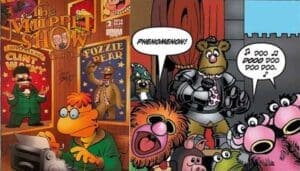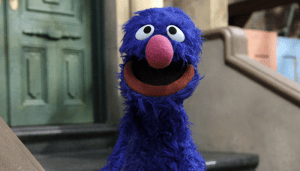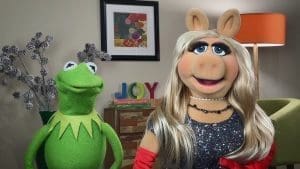For those who grew up in the 1990s, the opening theme song of “Dinosaurs” likely conjures a wave of nostalgia, a reminder of a television landscape filled with unique and memorable family sitcoms. This particular show, however, stood out from the pack. It wasn’t just about relatable family dynamics; it featured a family of dinosaurs living in a prehistoric world that eerily mirrored modern suburban life. Centered around the Sinclair family, the series masterfully blended humor, groundbreaking animatronics, and a surprisingly sharp social commentary, captivating audiences across different age groups. This article delves into the various elements that made “Dinosaurs” an iconic show, exploring its creation, characters, satirical premise, technical achievements, reception, cultural impact, and its unforgettable, albeit controversial, conclusion.
The journey to bring “Dinosaurs” to the small screen began with the imaginative mind of Jim Henson in 1988. Initially conceived as a collaborative dinosaur film project titled “The Natural History Project,” the concept evolved into a television series under the development of Disney in 1990. Sadly, Henson passed away in May 1990, before the show aired. However, his initial vision of a world where dinosaurs coexisted in a society reflecting modern human life, complete with corporations and family values, served as the foundation for the series. Disney’s involvement proved crucial in ensuring the show reached a wide audience, drawn in by its innovative puppetry and engaging storytelling. While Henson did not live to witness his dino-vision come to life, his influence permeated the series, from its unique aesthetic to its distinctive humor. Executive producers Brian Henson, Jim’s son, and Michael Jacobs played pivotal roles in translating Henson’s concept into the beloved sitcom that aired on ABC. Setting the show in Pangaea, approximately 60 million years BC, provided a unique backdrop against which contemporary human issues could be explored through the lives of the Sinclair family. The production, however, was not without its challenges. The sheer scale of the animatronic puppets, some reaching heights of seven to eight feet, presented unexpected complexities for the cast and crew, requiring innovative solutions on set.
At the heart of “Dinosaurs” was the endearing, albeit often dysfunctional, Sinclair family. Leading the pack was Earl Sneed Sinclair, the 43-year-old Megalosaurus patriarch. Voiced by Stuart Pankin, Earl was portrayed as a thick-headed but ultimately good-hearted father working as a Tree Pusher for the WESAYSO Development Corporation. His constant struggles with his boss and his often misguided attempts to provide for his family formed the comedic backbone of many episodes. His loving wife, Fran Phillips-Sinclair, an Allosaurus, served as the patient and often more sensible voice of reason within the household. Voiced by Jessica Walter, Fran juggled her role as a homemaker with the everyday chaos of family life. Their eldest child, Robert Mark “Robbie” Sinclair, a teenage Hypsilophodon voiced by Jason Willinger, often challenged societal norms with his rebellious spirit, embracing vegetarianism and pacifism, much to his father’s dismay. The middle child, Charlene Sinclair, a fashion-conscious Protoceratops voiced by Sally Struthers, navigated typical teenage experiences with a dino twist. However, it was the youngest member, Baby Sinclair, a Megalosaurus voiced by Kevin Clash, who became the breakout star. Known for his mischievous antics, his penchant for hitting Earl with frying pans, and his iconic catchphrases like “Not the mama!” and “I’m the baby, gotta love me!”, Baby Sinclair quickly captured the hearts of audiences. Rounding out the main family was Ethyl Hinkleman Phillips, Fran’s cranky Edmontonia mother, voiced by Florence Stanley. Ethyl, often seen in her wheelchair, provided a constant source of humorous friction, particularly in her interactions with Earl. Notable supporting characters included Earl’s tyrannical boss at WESAYSO, B.P. Richfield, and Earl’s loyal friend, Roy Hess. The Sinclair family, in their prehistoric yet remarkably modern setting, mirrored the typical American nuclear family, allowing viewers to connect with their everyday struggles and triumphs despite their reptilian exterior. Baby Sinclair’s immense popularity underscored the power of simple, memorable catchphrases and physical comedy in forging a connection with audiences. The contrasting personalities within the family created a rich dynamic for exploring a wide range of social issues through comedic scenarios.
| Character Name | Species | Voiced By | Notable Personality Traits | Role in Family |
|---|---|---|---|---|
| Earl Sneed Sinclair | Megalosaurus | Stuart Pankin | Thick-headed, good-hearted, hardworking (as a Tree Pusher) | Father |
| Fran Phillips-Sinclair | Allosaurus | Jessica Walter | Patient, sensible, caring homemaker | Mother |
| Robert Mark “Robbie” Sinclair | Hypsilophodon | Jason Willinger | Rebellious, questioning, vegetarian, pacifist | Eldest Son |
| Charlene Sinclair | Protoceratops | Sally Struthers | Fashion-obsessed, typical teenager | Middle Daughter |
| Baby Sinclair | Megalosaurus | Kevin Clash | Mischievous, prone to violence (towards Earl), known for catchphrases | Youngest Son |
| Ethyl Hinkleman Phillips | Edmontonia | Florence Stanley | Cranky, enjoys teasing Earl, Fran’s mother | Grandmother |
“Dinosaurs” was far more than just a sitcom with talking reptiles; it cleverly used its prehistoric premise to deliver sharp satire and insightful social commentary on a variety of contemporary issues. Environmentalism was a recurring and prominent theme throughout the series. Earl’s job at the WESAYSO Corporation, often involving the destruction of forests, served as a constant reminder of humanity’s potential impact on the environment. The show even subtly critiqued the fossil fuel industry by naming characters after oil companies, such as Sinclair, Phillips, Hess, and B.P. Richfield. Beyond environmental concerns, “Dinosaurs” fearlessly tackled a range of social issues. Episodes addressed civil rights through the dynamic between two-legged and four-legged dinosaurs , racism , sexism in the workplace in the episode “What ‘Sexual Harris’ Meant” , drug abuse in “A New Leaf” , the absurdity of war in the two-part episode “Nuts to War” , class struggles, workplace dynamics, and even questioned the nature of religion in “The Greatest Story Ever Sold”. The portrayal of the WESAYSO Corporation as a profit-driven entity often prioritizing its bottom line over the well-being of the planet and its inhabitants served as a biting critique of capitalism and corporate greed. The show even exhibited a degree of self-awareness, offering satirical takes on the television medium itself. By using dinosaurs as its central characters, “Dinosaurs” found a unique way to explore sensitive and complex topics without alienating its audience or appearing overly didactic. This allegorical approach allowed the show to reflect societal issues in a humorous yet thought-provoking manner. The consistent use of satire and social commentary suggests a deliberate intention by the creators to use the show as a platform for addressing relevant societal issues, elevating it beyond mere family entertainment. The show’s ability to tackle controversial topics through allegory provided a clever means of engaging a broad audience, including younger viewers, with complex social issues. The recurring critique of the fossil fuel industry and corporate practices foreshadowed the show’s dramatic conclusion, emphasizing the consequences of unchecked industrialization and environmental neglect.
The visual appeal and unique charm of “Dinosaurs” stemmed significantly from its groundbreaking animatronics and puppetry, brought to life by Jim Henson’s Creature Shop. The show featured life-size dinosaur puppets, a remarkable feat of engineering and performance for television at the time. Operating these complex puppets, some of which were enormous, presented considerable challenges for the performers. However, the technological innovations employed were equally impressive. The full-body costumes were radio-controlled, allowing for a wide range of movements and expressions from the dinosaur characters. Buttons were even used to control entire facial expressions, such as surprise or joy, representing an advancement from Henson’s earlier work. A dedicated team of actors and puppeteers worked tirelessly to bring the Sinclair family and their prehistoric world to life. This included not only the voice actors but also the performers who inhabited the bulky animatronic suits. Compared to Henson’s earlier creations on “Sesame Street” and “The Muppet Show,” the animatronics in “Dinosaurs” represented a significant leap in technology and complexity. The unique look and feel of these puppets have undoubtedly contributed to the show’s nostalgic appeal for many viewers today. Despite the advanced technology, filming with these large and intricate puppets was a constant exercise in creating an “illusion” for the camera, requiring careful planning and execution for every shot. The groundbreaking animatronics were a key element in the show’s initial popularity, distinguishing it from other sitcoms of the era. The physical demands on the performers highlighted their dedication to the craft. The success of “Dinosaurs” with its innovative animatronics likely influenced future television productions that aimed to push the boundaries of practical effects.
“Dinosaurs” roared onto television screens in April 1991 and quickly became a hit with audiences. It found a comfortable spot within ABC’s popular TGIF lineup, sandwiched between other family-friendly shows. The show’s popularity was further evidenced by the success of its merchandise, including a wide array of toys and items featuring Baby Sinclair’s memorable catchphrases. Critics often drew comparisons between “Dinosaurs” and other successful sitcoms of the time, such as “The Simpsons,” “Roseanne,” and “All in the Family,” recognizing its blend of humor with underlying social commentary. Families across the nation tuned in weekly, and Baby Sinclair’s “Not the mama!” became a ubiquitous phrase in playgrounds and households. However, as the show progressed and began to tackle increasingly darker themes, particularly in its later seasons, some viewers may have found the tone shifting away from lighter family comedy. Despite this, the show has experienced a resurgence in popularity and appreciation in recent years, especially with its availability on streaming platforms like Disney+. While the majority of viewers fondly remember the show, some have expressed mixed opinions on certain characters, such as Baby Sinclair, with a few finding his antics more irritating than endearing. The show’s initial popularity stemmed from its novel premise, memorable characters, and its ability to address social issues humorously. Comparisons to established sitcoms highlighted its satirical nature and its place within a tradition of socially conscious comedy. The willingness to explore darker themes, while potentially contributing to its eventual cancellation, also set it apart and made it more thought-provoking than typical family sitcoms.
The cultural footprint of “Dinosaurs” extends beyond its original run, leaving an enduring legacy in popular culture. Baby Sinclair’s catchphrases, most notably “Not the mama!”, have become deeply ingrained in the cultural lexicon, instantly recognizable even to those who may not have watched the show regularly. While its direct influence on other television shows might be debated, “Dinosaurs” certainly contributed to the landscape of sitcoms that were willing to push boundaries and incorporate more than just lighthearted comedy. What makes “Dinosaurs” particularly remarkable is its continued relevance today. Its themes, especially its strong environmental message and its critique of corporate greed and societal issues, resonate with contemporary audiences facing similar challenges. For many, the show also evokes a strong sense of nostalgia for 90s television, a period often remembered for its unique and creative programming. The enduring appeal of “Dinosaurs” has even led to discussions and potential ideas for a revival, highlighting the lasting connection audiences still feel with the Sinclair family and their prehistoric world. Beyond its humor and satire, the show also subtly imparted educational value, introducing audiences to prehistoric life while simultaneously prompting reflection on important social and environmental issues. The lasting impact of Baby Sinclair’s catchphrases underscores the power of simple, memorable lines in achieving cultural recognition. The show’s continued relevance highlights its prescient writing and the enduring nature of the issues it addressed. The potential for a revival suggests the strong connection audiences still have with the show’s characters and its unique blend of comedy and social commentary.
Throughout its four seasons, “Dinosaurs” delivered numerous memorable episodes that resonated with viewers and sparked discussion. While the series finale, “Changing Nature,” stands out as perhaps the most talked-about, several other episodes left a lasting impression. “A New Leaf” offered a satirical commentary on drug use through the introduction of a “happy plant” that affected the Sinclair family. The two-part episode “Nuts to War” cleverly satirized the Gulf War and explored themes of prejudice through a conflict over pistachio nuts. “What ‘Sexual Harris’ Meant” bravely tackled the issue of sexual harassment in the workplace, a topic rarely seen in family sitcoms at the time. “The Greatest Story Ever Sold” offered a humorous yet pointed satire of religion and the human need for answers about origins. Environmental concerns were highlighted in “Endangered Species,” where Earl sought a rare creature for his anniversary dinner. “Hurling Day” presented a darkly comedic look at a bizarre societal custom, prompting reflection on tradition and morality. The challenges of raising a toddler were hilariously exaggerated in “The Terrible Twos,” which parodied the horror film “The Exorcist”. And “The Golden Child” satirized celebrity and leadership when Baby Sinclair inexplicably grew a golden horn and was declared king. These episodes demonstrate the show’s ability to blend its comedic premise with meaningful explorations of social and environmental issues, often using satire and parody to engage audiences in thought-provoking ways. The most memorable episodes often directly addressed significant societal issues through a satirical lens, showcasing the show’s commitment to being more than just a source of laughter. The show’s willingness to incorporate parodies of popular culture further broadened its appeal and highlighted its clever writing. Even seemingly absurd storylines often contained underlying satirical commentary on human behavior and societal structures.
The series finale of “Dinosaurs,” titled “Changing Nature,” aired on July 20, 1994, and remains one of the most unforgettable and controversial endings in television history. The episode took a stark departure from the show’s usual comedic tone, presenting a dark and depressing conclusion where the Sinclair family, along with all other dinosaurs, faced extinction due to an environmental catastrophe. The plot centered on the WESAYSO Corporation’s destructive practices, which led to the extinction of a crucial beetle species. This, in turn, caused an overgrowth of plants, which Earl attempted to eradicate with a defoliant. Tragically, the defoliant killed all plant life on Pangaea, leading to famine. In a desperate attempt to reverse the damage, Earl’s boss convinced him to bomb volcanoes to create rain clouds, a misguided effort that instead blocked out the sun and triggered a devastating ice age. The final scenes depicted the Sinclair family huddled together in their home as the snow fell, facing their inevitable demise. The creators intended this bleak ending to serve as a powerful and uncompromising message about the consequences of environmental negligence and corporate greed, highlighting the real-world concept of extinction. While many viewers were shocked and saddened by the dark turn, finding it too bleak for a family sitcom, others praised its boldness and the powerful social commentary it delivered. The ending remains a significant point of discussion among television fans, remembered for its unflinching portrayal of environmental destruction and its subversion of typical sitcom tropes, which usually offer a happy resolution. The controversial ending was a deliberate choice by the creators to emphasize the show’s environmental themes in a memorable way. The emotional impact on viewers demonstrated the effectiveness of the show’s character development. The finale’s enduring discussion highlights the power of taking creative risks in television storytelling.
Despite its prehistoric setting, “Dinosaurs” remains a remarkably relevant and enduring piece of television. Its unique premise, coupled with its memorable characters and groundbreaking animatronics, made it a standout show of the 1990s. However, it was the show’s sharp satire and willingness to tackle thought-provoking social and environmental issues that truly set it apart. The themes explored in “Dinosaurs,” particularly environmentalism and the critique of societal problems, continue to resonate deeply with contemporary audiences. For many, the show also holds a significant nostalgic value, representing a beloved part of their childhood television viewing. Even the show’s controversial ending, while shocking, served as a powerful and lasting message about the consequences of our actions. “Dinosaurs” stands as a testament to the fact that even seemingly lighthearted entertainment can be a potent vehicle for social commentary and raising awareness about important issues. For those who haven’t revisited the Sinclair family in a while, or for new viewers curious about this iconic show, “Dinosaurs” on streaming platforms offers a chance to experience a unique blend of humor, heart, and surprisingly prescient social commentary.




